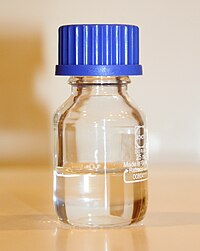
Photo from wikipedia
The rational development of new electrolytes for lithium batteries rests on the molecular-level understanding of ion transport. We use molecular dynamics simulations to study the differences between a recently developed… Click to show full abstract
The rational development of new electrolytes for lithium batteries rests on the molecular-level understanding of ion transport. We use molecular dynamics simulations to study the differences between a recently developed promising polymer electrolyte based on poly(pentyl malonate) (PPM) and the well-established poly(ethylene oxide) (PEO) electrolyte; LiTFSI is the salt used in both electrolytes. Cation transference is calculated by tracking the correlated motion of different species. The PEO solvation cage primarily contains 1 chain, resulting in strong correlations between Li+ and the polymer. In contrast, the PPM solvation cage contains multiple chains, resulting in weak correlations between Li+ and the polymer. This difference results in a high cation transference in PPM relative to PEO. Our comparative study suggests possible designs of polymer electrolytes with ion transport properties better than both PPM and PEO. The solvation cage of such a hypothetical polymer electrolyte is proposed based on insights from our simulations.
Journal Title: ACS macro letters
Year Published: 2023
Link to full text (if available)
Share on Social Media: Sign Up to like & get
recommendations!